Originally, Walt Disney planned to make a full length feature film featuring Winnie the Pooh but found himself confronting a serious problem: even taken together, the books didn’t create a single story, except—and this is very arguable—the story of Christopher Robin finally growing up, which for the most part is contained in the final chapter of The House on Pooh Corner and hardly qualifies as an overreaching storyline. Character development, again with the exception of Christopher Robin, was also non-existent: the basic point of that final chapter in The House on Pooh Corner is that the One Hundred Acre Forest will always exist, unchanged, and that someplace on that hill, a boy and his bear are still playing.
Faced with this, Walt Disney ordered a new approach: a series of cartoon shorts, strongly based on the stories in the original two books. Initially appearing between 1966 and 1974, the cartoon shorts were bundled together with a connecting animation and a short epilogue to form the 1977 feature The Many Adventures of Winnie the Pooh, with Christopher Robin’s voice re-recorded (he was voiced by three different children in the original shorts) to maintain consistency.
(Quick note: Legally, it’s Winnie-the-Pooh if you are referring to the book character, Winnie the Pooh (no hyphens) to the Disney version.)
If you are expecting an unbiased review of this film, reduce your expectations now. I did not see the 1977 release, but two of the shorts were small me’s very very very favorite Disney films ever. Oh, sure, Cinderella had those mice and that beautiful sparkly dress, and Lady and Tramp had cute dogs, and Aristocats had singing cats, and I was firmly escorted out of Bambi thanks to a complete inability on my part to distinguish animated forest fires from real forest fires, but The Many Adventures of Winnie the Pooh had Tigger. Who bounced and bounced and bounced. I laughed and laughed and laughed. Small me also was blown away by the image of the characters using the text of the book to climb out of various problems, and the image of letters in the book getting blown by the wind and hitting the characters. Those scenes were arguably among the most formative film moments of my childhood, still impacting my approach to writing fiction today.
Also, Tigger.
Because of this, I steadfastly avoided watching the film as a grownup, not wanting my little wondrous childhood memories shattered. And then this Read-Watch came up. I considered. And considered again. And finally pressed the play button on Netflix.
Does it hold up?
Well, almost.
Grown-up me is not quite as entertained by the images of Tigger bouncing on everyone—I’m not at all sure why that made me laugh so hard when I was small, but there we are. Small me had Very Little Taste. Grown-up me had also just read the books, and couldn’t help finding the books just a little better. Child me completely missed just how much of the film contains recycled animation sequences, though to be fair I originally saw the film in separate shorts, where the recycling isn’t quite as obvious. Adult me also can’t help noticing the differences in animation techniques and colors as the movie progresses, which is slightly distracting. Child me was also wrongly convinced that the film had a lot more Eeyore in it (apparently not) leaving grown-up me a little disappointed. And in the intervening years, grown-up me somehow or other got a slightly different voice in her head for Pooh, which was slightly distracting, though the voicing for Piglet and Tigger is spot on.
And adult me is just a little sad that the film does not use the silly rhymes Milne wrote for both books, and—especially in the first short—exchanges some of Pooh’s literal dialogue for phrases like “rumbly in his tumbly,” and the rather unbelievable bit of dialogue where Pooh—Pooh—knows that Heffalumps and Woozles are actually Elephants and Weasels. That is just not the sort of thing that Pooh would know. At all. Not that Tigger, the one saying Heffalumps and Woozles, would know either, but let us not give Pooh too much education here.
And also—and I stick to this—the Hundred Acre Wood doesn’t have elephants. Or weasels. It has Heffalumps. And Woozles. And one Tigger.
But—and this may be nostalgia coloring my viewpoint—other than things like this, The Many Adventures of Winnie-the-Pooh does hold up remarkably well.
The film starts off with a glimpse of Christopher Robin’s room, scattered with various toys, including American versions of the various stuffed animals that Christopher Robin plays with, before entering the book. And by this, I don’t just mean the fake gold covered books that Disney had used in opening scenes for its fairytale books, but rather, the U.S. edition of Winnie-the-Pooh—complete with the table of contents, the text and page numbers, if with slightly altered illustrations—a point that would become critical in later court arguments in the state of California.
The lawsuits were still to come. For now, the slightly altered illustrations were just part of an artistic decision to let a little illustration of Christopher Robin that was almost (but not quite) like Ernest Shepherd’s Christopher Robin start moving on the screen, while the text remained steady, before the camera moves over the page to introduce us to the other characters in the film—Eeyore, Kanga, Roo, Owl, Rabbit, Piglet and Pooh—before having Pooh step out of his house and merrily jump across letters that spell out BEARS HOWSE.
It’s a fun animated sequence, and also a nice nod to the original Winnie-the-Pooh, which itself existed in an odd limbo between reality and story, where two of the main characters in the stories were real people—well, a real boy and a real teddy bear—asking to hear stories about their adventures in the woods, and getting upset if they weren’t mentioned in these tales—but who were also fictional characters, raising questions of the relationship between narrative and reality.
The Many Adventures of Winnie-the-Pooh never gets that deep—the closest it ever gets to “deep,” actually, is a hug between Rabbit and Tigger later on in the movie, and I’m seriously stretching the definition of “deep” here. But the animators did play with the relationships between characters and text. Pooh speaks directly to the narrator, complaining that he doesn’t want to go on to the next part of the film—he’s eating honey! Priorities, narrator, priorities! I’m with Pooh on this one. In the blustery day portion of the film, Pooh gets hit by letters from the book. Tigger, stuck in a tree, calls out to the narrator for help, who tells him to move to the text—and then kindly turns the book, just a little, so that Tigger can slide down the letters instead of having to jump down from the tree.
As the film continues, pages turn, letters fly, the narrator kindly reminds us what page numbers we are on, and Gopher—the one character not in the book—reminds us from time to time that he’s not in the book, and when he later mostly disappears from the film, it’s ok, because he’s not in the book. And also because Gopher is not very funny. He’s a replacement for Piglet, who is very funny, but who for whatever reason—stories differ—was left out of the first short. Critics howled, and Piglet was back for Blustery Day and Tigger Too, along with the bouncy Tigger.
The animators also had fun with a dream sequence where Pooh dreams about heffalumps—clearly heffalumps, not elephants, in weird shapes and sizes—and with a great sequence during Blustery Day where Owl’s house is blown down, while Owl and Piglet and Pooh are still in it. Alas, the great bit that followed in the book, where Piglet got a chance to be brave by climbing out of Owl’s mailbox, is gone—but Piglet still gets a great scene later, made even more poignant by the number of characters who know just how brave and selfless Piglet is.
As the film progressed, animators had more and more fun with the text—which also meant they were forced to take more and more dialogue from the text, since viewers could see it up on the screen. That greatly improved the film’s second two sections. I don’t mean to disparage the first short, exactly—especially with the great scene where Rabbit, realizing he’s stuck having Pooh in his door for some time, tries to turn Pooh’s rear end into something at least slightly artistic—but it’s just not as funny as the rest of the film, which stuck closer to the book. The animation, too, looks rough. In some cases, this is all to the good—the rough transfer process to animation cels meant that a lot of rough pencil marks got transferred too, giving Pooh, in the first short, a slightly messier, rougher look that was a little closer to the Ernest Shepard originals. In other scenes, this is a lot less good; the later shorts, created after Disney had more experience with the new xerography technique, look cleaner and brighter.
The rest of the film does, admittedly, take more liberties with the plot (what there is of it), combining the flood story from Winnie-the-Pooh with the blustery day and finding a house for Owl stories in The House at Pooh Corner, for instance. And at no point can I remember the Pooh in the book staring at length at his reflection in the mirror and talking to it, while remaining completely unaware that the Pooh in the mirror is, well, not a completely different bear. (Though, for the record, when you are four years old, this is also really really funny if not quite as funny as Tigger bouncing, so this is an understandable addition.) I can’t remember book Pooh singing, “I am short, fat, and proud of that,” as an excuse to eat more honey. And I rather miss Pooh’s ability—however accidental—to solve certain problems and triumph by finding the North Pole.
But despite these tweaks to dialogue and characters, and changes to the plot, this remains one of Disney’s most faithful literary adaptations—which, granted, may not be saying much, especially after what happened to The Jungle Book. It ends with dialogue taken word for word from The House at Pooh Corner, and with the same wistful hope, and if Milne purists decried the results, I still can’t help regarding it with warmth.
Also, Tigger.
Paul Winchell, the ventriloquist who voiced Tigger, earned a Grammy Award for the Winnie the Pooh and Tigger Too! part of the film. He went on from this to voice Gargamel in The Smurfs, which no doubt says something deep about life and Hollywood, but also is no doubt something we don’t want to examine too closely. The second short won an Academy Award for Best Animated Short film, and the bundled film, if not a box office blockbuster, at least earned enough money to pay for the added animation. And although Walt Disney died before the third short was produced, it was the last of the Disney animated classics that could claim Walt Disney’s personal involvement, and along with The Rescuers helped director Wolfgang Reitherman, who had more or less taken over Walt Disney’s supervising animation role, keep his job after the tepid The Aristocats and Robin Hood. It was also one of the first animated films that Don Bluth worked on, giving him training in the art—someone we’ll be discussing a bit more when we come to The Fox and the Hound.
But for Disney, the long term legacy of the film was twofold: money (a lot of it) and lawsuits (a lot of this too).
Disney lost no time marketing merchandise based on the film, which soon outsold products based on (gasp!) Mickey Mouse himself. To this day, even post the introduction of Disney Princesses, Disney Fairies, and Buzz Lightyear, Pooh remains one of Disney’s most valuable assets, featured in toys, clothing, jewelry, and various household items. Pooh also has his Very Own Ride at Disneyland, Walt Disney World’s Magic Kingdom, and Hong Kong Disneyland (all accompanied, of course, by a store), and several of the characters make regular appearances at the theme parks.
The issue, of course, was who exactly would get the money—as much as $6 billion annually, if estimates from Forbes are correct—from all of this. Not necessarily the Milne estate: A.A. Milne had sold rights for nearly everything except for publication over to Stephen Slesinger, Inc, including, a U.S. court later agreed, rights for toys. Not necessarily Disney, who had—technically—only licensed the film rights, not additional rights—at least according to Stephen Slesinger, Inc. Disney, however, argued that the film rights included the rights to create and sell merchandise based on the film Pooh characters, sometimes calling the book characters created by Milne/Shepard “classic Pooh,” except when creating certain Disney products also called “classic Pooh.” Disney also later licensed additional rights from the Pooh Properties Trust and from Stephen Slesinger’s widow, Shirley Slesinger Lowell. And just to add to the confusion, some of these properties were trademarked, some copyrighted.
Not surprisingly, the confusion over all this, and the genuine difficulty of consistently distinguishing between “Classic Eeyore” and “Disney Eeyore,” led both groups into an extensive and expensive legal fight that lasted for eighteen years, with nasty accusations from both sides: Disney, for instance, was accused of destroying 40 boxes of evidence; in turn, Disney accused the Slesinger investigators of illegally going through Disney’s garbage. A.A. Milne’s granddaughter stepped in, attempting to terminate Slesinger’s U.S. rights to Disney, a lawsuit that—perhaps because it didn’t involve questionable legal or investigative practices—went nowhere despite eight years of additional wrangling.
A 2009 federal court decision granted all copyright and trademark rights to Disney, while also ordering Disney to pay royalties to the Slesingers. That still left Disney in control of most of the revenue from Winnie the Pooh, making the character one of Disney’s most valuable properties. With the exception of Disneyland Paris, every Disney theme park has a Winnie the Pooh attraction and attached store, as will Shanghai Disneyland Park, opening in 2016. An incomplete list of Winnie the Pooh Disney merchandise includes toys, jewelry, clothing, games, cellphone cases, backpacks, fine art, and Christmas tree ornaments. Estimated sales have led Variety to list the Winnie the Pooh franchise as the third most valuable in the world, behind only Disney Princesses and Star Wars—also owned by Disney.
It was an incredible return on what were initially just three cartoon shorts featuring a small bear of Very Little Brain, which, even before that dizzying marketing success, had done well enough to encourage Disney executives to take another look at animation. Sure, The Aristocats and Robin Hood had failed to take the world by storm, and Walt Disney was no longer around to inspire films, but the 1974 short had gained a lot of positive attention, and the studio had this little thing about mice hanging around.
The Rescuers, coming up next.
Mari Ness lives in central Florida.










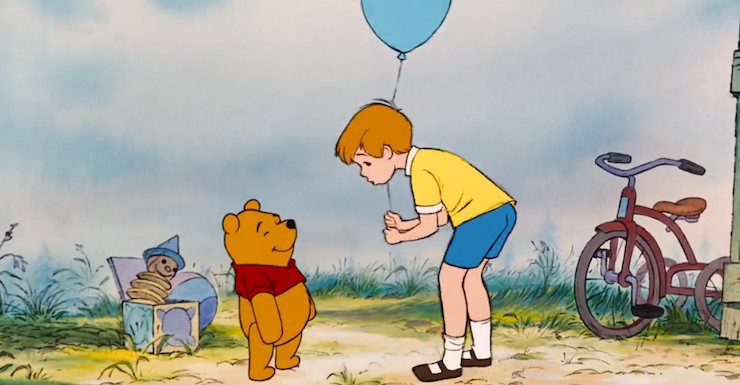
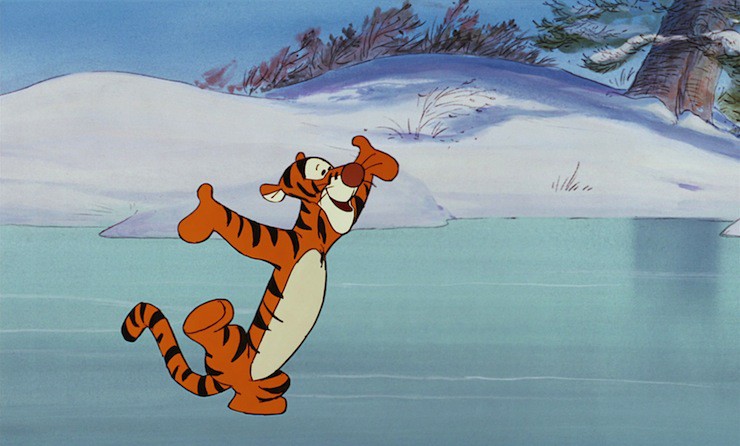
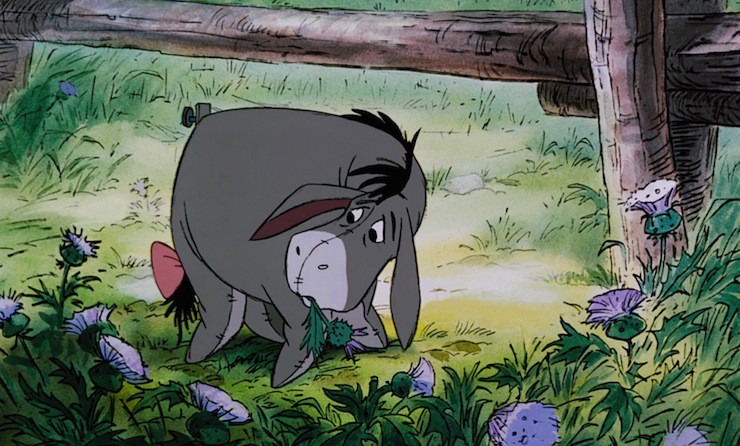
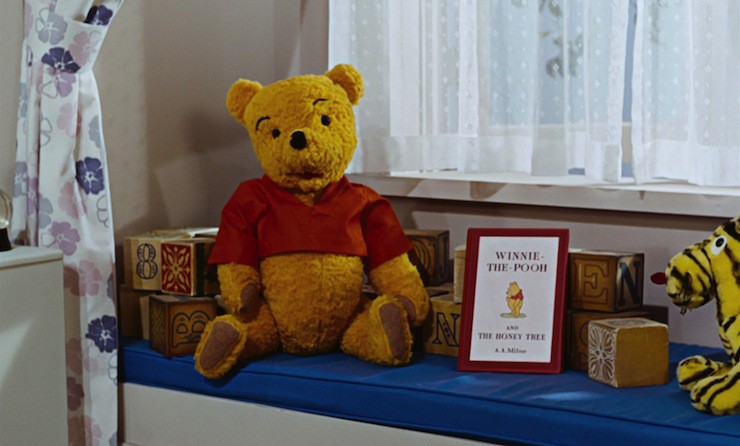
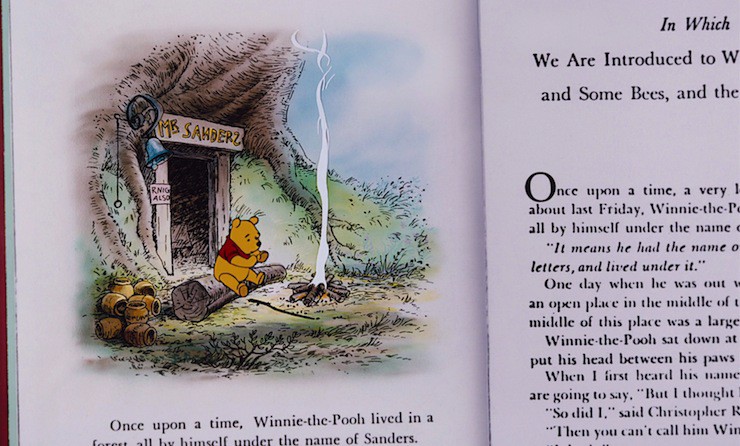

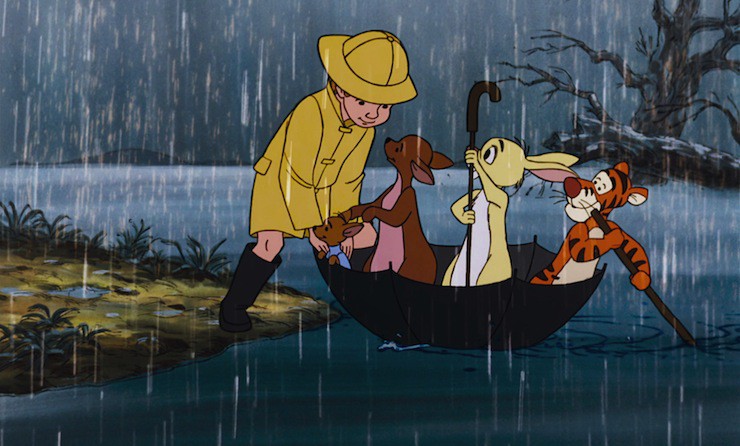
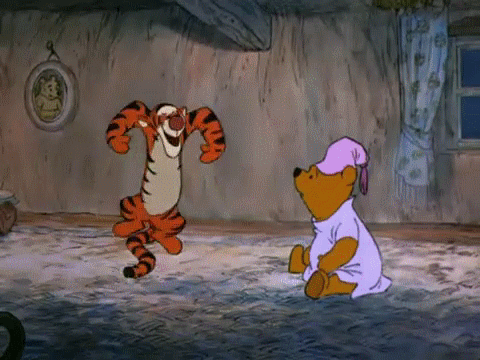
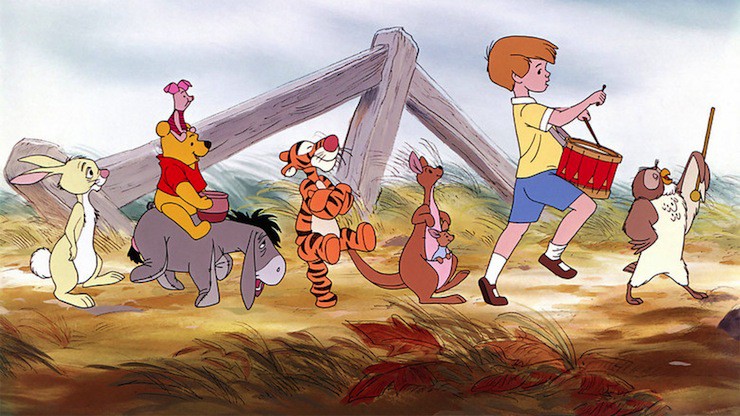
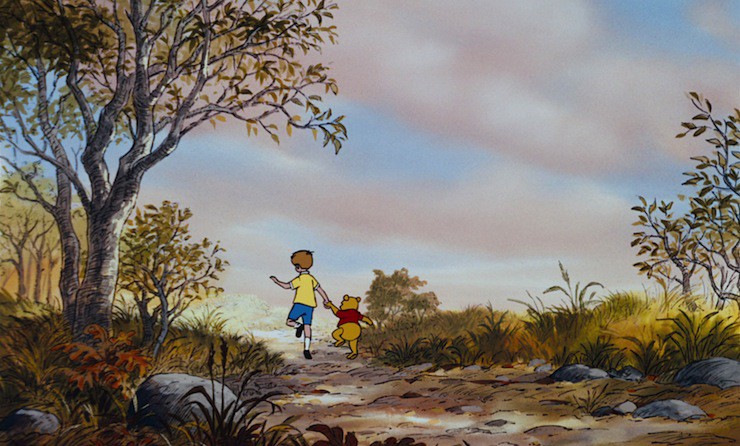
I had a tape of the honey tree short when I was little and I just loooooved it :) I always felt bad for Rabbit though…he’s probably the character I’m the most like, lol.
Have you seen the movie that came out in 2011 or 2012? It was…actually a little offputting to me. I feel like all of the characters were taken to extremes (Rabbit is REALLY Neurotic and Owl is REALLY pedantic, etc) and there was some (cartoon) violence that was actually a little jarring to me. But the weird honey acid sequence is kind of funny :)
The “Heffalumps and Woozles” dream-sequence has more than a passing resemblance to the “Pink Elephants on Parade” hallucination in DUMBO, although minus the latter’s rather notorious sexual imagery.
When my nephews were toddlers Winnie the Pooh was one nephews favorite and his brothers was Toy Story. We watched those movies everyday for quite a while. If you put either movie on today I can now recite the dialog to both films. I don’t think I remember the heffalumps sequence though. It has been a long time since I sat and watched pooh Andrew turned 19 last week and his brother turns 21 in April. I may see if I can find a copy of the movie and the first book for their 2nd cousins first birthday next month. I like the 70’s version best. I’ve never read the books.
When the first Kingdom Hearts game came out, I was a senior in high school. There is a part where you go into a storybook and I did not know what to expect. The camera panned over to a yellow bear sitting on a log trying to remember, trying to think. I just sat there and cried because Pooh is such a beautiful, important bear
These were some of my favorites when I was little and Rabbit was that last stuffed animal that stayed in my bed a little longer than is really expected.
And there are some good things, but there are now so many other associations for me that I can’t really look at them objectively any more. Paul Winchell was indeed a terrific ventriloquist and I watched his show a lot when I was a kid in Los Angeles. He also designed the first artificial heart and my degree is in biomedical engineering. I can’t hear Piglet without hearing that voice ranting “Die! die! Kill you all” (from the Star Trek episode “Wolf in the Fold”. “The Rain, Rain, Rain Came Down, Down, Down” is also a severe earworm. And as much as I love Tigger, when my youngest daughter saw “Tigger Too” for the first time she proceeded to spend the next several hours sticking things in plastic eggs and presenting them to me, shouting “Purise!”
I haven’t seen the shorts, but I have seen the recent movie, and it’s nice to know that the opening in the bedroom and the use of literal letters are homages to the original animations.
(It’s great for very young kids, and the songs are earwormy as hell.)
Everyone: I haven’t seen any of the later Winnie the Pooh films yet. I liked my memories of this one too much to risk tarnishing them.
@Russell H – It’s very possible that the Winnie the Pooh animators had Dumbo in mind – Dumbo continued to earn money every time it was released, and animators were always hoping to recapture its popularity. The Heffalump sequence, though, is a lot less scary – possibly because of the music, possibly because it’s a bit less nightmarish.
@DemetriosX – I never saw his show, but Paul Winchell voiced so many roles that I can understand the association issues! Fortunately almost all of my memories of The Smurfs have mercifully retreated, so I can mostly remember and appreciate him as Tigger.
aww, I had the storybook record when I was a kid and loved it to bits. I haven’t actually seen the film in forever, but I have very clear memories of the pictures, especially when Winnie the Pooh gets stuck because that was hilarious.
When my son was born, my mother in law started to make large crocheted stuffed animals for him of the Pooh characters. We have Pooh and Piglet, but Tigger, sadly, was never finished.
Though more humorously, my son has kind of grown up with Peter Cullen, who was the voice of Eeyore through all the Winnie the Pooh direct-to-video movies/shorts (up to the new movie, I guess) and he’s also the voice of Optimus Prime in all the recent Transformers things. Every time Optimus speaks I think of Eeyore saying those lines and it cracks me up.
I actually rather like the new Winnie the Pooh movie (though not the earlier sequels, which are Disney Movies™ with a Winnie the Pooh gloss.) The animators went back to the books and constructed a decent through-plot based on several of the book stories. Plus Christopher Robin actually has a British accent, which helps. There’s several jokes for adults that aren’t being snide to the kids, like sticking a deliberate non-rhyme in one of the songs. And Huell Howser gets a post-credits cameo.
My kids were given the DVD as a gift and I was prepared to be annoyed by it (since I’ve *seen* The Tigger Movie.) So I was pleasantly surprised by it as a movie that wasn’t going to grate on my nerves when the kids wanted to watch it repeatedly.
Paul Winchell was Gargamel? I had the impression it was Hans Conreid. Maybe Winchell was doing a Conreid impression?
@8: Peter Cullen was, in fact, the original voice of Optimus Prime back in the ’80s, even before he became Eeyore. (He was pretty much ubiquitous in animation in the ’80s.) He returned to the role for the movies in 2007 and for subsequent animated series starting in 2010.
Yep, Paul Winchell was the original 1980s Gargamel. And Baby Smurf. (Aside, Baby Smurf? So glad I repressed this.) He was also Zymmi Gummi from The Gummy Bears (I remember this one being dreadful even by 1980s cartoon standards) and a couple of other minor characters here and there.
Peter Cullen was also in The Smurfs AND The Gummy Bears, and as various characters in Chip ‘n Dale Rescue Rangers, along with, of course, DuckTales, Transformers, G.I. Joe, Rainbow Brite, Dungeons and Dragons, Alvin and the Chipmunks, the American version of Voltron: Defender of the Universe, and Spider-Man and His Amazing Friends. In recent years his job of “voice everything” seems to have been taken over by Jim Cummings, who currently voices Winnie the Pooh and Tigger.
Heh. I also watched Many Adventures countless times as a kid (plus many episodes of the TV show, which is a whole ‘nother pile of hilarious ridiculous.). And I also loved Tigger — but adored Gopher because reasons. I had mixed feelings about the first short, disliking the part with bees (the glimpse of Pooh’s bee-covered paw slightly traumatized me) but enjoying the “stoutness exercises” and loving the hell out of the second half despite feeling sorry for Rabbit.
“The only reason for making a buzzing noise that I know of is because you’re a bee. And the only reason for being a bee is to make honey. And the only reason for making honey is so I can eat it.” A highly problematic attitude in our world, but Pooh can state it (in book and film) and still be lovable.
@2: These two, plus Fantasia and other cultural artifacts, have persuaded me that “Everything is Trippier with Elephants” should be an official trope, although it apparently isn’t. And some bits of “Heffalumps and Woozles” were directly recycled from “Pink Elephants.” I much prefer H&W.
@mari: TV Tropes recently sent me to your enjoyable Madeline L’Engle reread. Thanks.
@11/MariCats: Cummings is another one who’s far from recent; he started voicing Pooh at the same time Cullen started voicing Eeyore, in 1988, and took over Tigger from Winchell (on and off) starting in 1990. Back in the later ’80s, it seemed to me that Cummings quickly took over a lot of the gravelly-voiced roles that would’ve gone to Cullen (or Ed Gilbert) a few years earlier. (He actually did replace Cullen as Monterey Jack on Chip ‘n’ Dale’s Rescue Rangers midway through the series.) Although Cummings had a greater range, considering that he could also do a voice like Pooh. I’ve often felt that the clearest indicator of Jim Cummings’s range is that he was the actor to take over the roles of both Winnie the Pooh and the Tasmanian Devil. But I’d say he peaked in the late ’80s and the ’90s; I haven’t heard as much from him in recent years. John DiMaggio seems to have surpassed him as the go-to guy for that particular type of voice.
Like MGM’s The Wizard of Oz, this is one of those properties you usually come by through film before the original book. Disney’s Pooh was very much my introduction to Milne’s world. I had a VHS of “Blustery Day” as a kid that wound up getting stuck in a VCR, costing us both the tape and the VCR! Later, I got a VHS of the movie version, but that later just stopped working for some reason.
I got a lot of funny looks when I, at age 21, bought a DVD copy of it. Whatever… When I joined Disney Movie Club, the Blu-Ray version was one of my super-cheap enrollment titles.
I have kind of bemoaned Disney’s treatment of Pooh. “Piglet’s Big Movie” and the 2011 “Winnie the Pooh” kind of get passes because they adapt more original Milne stories. I do, however, have a soft spot for “The Many Adventures of Winnie the Pooh” TV show, since it was on a lot when I was a kid.
Little reminder that “A Day For Eeyore,” mixing the Pooh Sticks story from “The House at Pooh Corner” and Eeyore’s birthday story from “Winnie-the-Pooh” into one narrative. It was edited into some TV versions of “Many Adventures” to fill out the time slot.
I kind of wish that someone aside from Disney could get another shot at Winnie-the-Pooh, though, as I’d like to see how someone else re-interprets the characters from the text. Just about the only other ones out there are Peter Dennis’ readings (he gives each character a unique, distinctive voice, including a sweet little “oink” for Piglet), and an episode of the Shirley Temple Show where the Pooh characters were depicted by puppets.
There are aspects of this movie/these shorts that I like very much, including the animated interaction between the characters and the text on the page. And Tigger. While I love Milne’s verse and dialogue, I don’t mind that Disney Pooh & Co. are less verbally sophisticated. My biggest problem with the movie is Pooh’s voice, which I have never liked, and which has never struck me as right for the character. I’m not good at imagining what a character’s voice *should* sound like, but I know when it sounds wrong, and Pooh’s voice seems all wrong to me.
That’s amazing, that the Pooh franchise is worth so much money! I never would have guessed that it would rank that high on Variety’s listing of most valuable franchises.
What’s weird is hearing these iconic voices coming out of completely different characters, especially in live action. Want to hear a slightly sinister Pooh as TV repairman? Cross over into the Twilight Zone.
https://www.youtube.com/watch?v=3HKzNp1KafY
Or how about a deranged Piglet in Star Trek?
https://www.youtube.com/watch?v=KdPDvGkvbFs
Oh dear.
@5: I still sleep with a stuffed hyena and have no intention of stopping
Oh are we playing the “bizarre places you hear Pooh’s voice” game?
Jim Cummings has gotten very involved in voice acting in video games. Do the Assassin’s Guild quests in Skyrim; he voices an older Mage assassin and I swear it’s his exact Pooh voice.
He’s also Rasputin in Bluth’s Anastasia.
#11: If I think too hard about Disney’s Eeyore and Dungeons & Dragons‘ Venger being voiced by the same person, my brain may explode. (I knew Peter Cullen had been both Venger and Optimus Prime. Prior to the present reread, I had not known he was Eeyore, too.)
#13: Between Peter Cullen, Jim Cummings, and Patrick Warburton, one can probably account for about a third of the male animated film and television voices dating back thirty years or so. (Unfortunately, I don’t think Warburton’s voice appears in any Disney film eligible for inclusion in the present series.)
#18: Strictly, Cummings is the singing voice of Rasputin in Anastasia, while Christopher Lloyd does Rasputin’s non-musical dialogue.
Paul Winchell was also the voice of both roles in the painfully 70s animated version of Green Eggs and Ham, which I remember seeing several times as a child. He pretty much just reused his Tigger voice for that short (including Tigger’s trademark giggle-laugh, even), but somehow I never made the connection until I stumbled across that sequence as an adult…
@14/Jay D.: I think that in my house, we had the books first, though I think I remember the shorts being shown on the classroom projector in elementary school.
@19/John C. Bunnell: Warburton shows up a lot, but he specializes in doing that one particular bombastic/stupid character type. He’s not really a vocal chameleon like so many others. And as I said, neither Cullen nor Cummings is anywhere near as active today as they were in the ’80s and ’90s, though Cullen’s made a comeback in the wake of the Transformers movies.
I recommend a movie called I Know That Voice, which is available on Netflix streaming. It’s a documentary about animation voice artists, produced by John DiMaggio (Futurama‘s Bender, Batman: The Brave and the Bold‘s Aquaman, and countless others), and it has interviews with most of the major voice talents of the past few decades (except for Frank Welker, oddly enough).
I’m just at the age were my first introduction to Pooh was on the Saturday morning cartoon, The new adventures of Winnie the Pooh. I remember loving that and trying to catch it every Saturday. I still have the Christmas special on an old VHS that we recorded from the TV. So many good memories, it makes me sad to think about how much unhappiness it brought Milne and his son.
@14
There are some soviet-era Russian shorts of the classic Winnie Pooh stories that I kind of adore. This should link to the first one: http://www.youtube.com/watch?v=sqdiEUp6s4E . They have a completely different aesthetic and are a little wilder and sillier than the Disney version.
@23 Ah, yes, I’ve seen those around and have been meaning to watch them. I’ve enjoyed quite a bit of Soyuzmultfilm’s output, so it’s odd I haven’t watched them yet.
I just located my VHS of this in time for this re-read slot. Ahh, the wonderful snuggly nostagia. The heffalumps sequence terrified me, as did the tigger in the forest bit (they still do scare me) I think because it was slightly out of link with the feel of the film. The rest is my precious childhood.
Although the copyrights stories are very interesting, mini-you’s reactions are clearly the best part of those reviews. Could you find a replacement mini-you to see how children react to those books and movies today?
I never saw the complete version of this as a kid, but I had a book-tape of “Winnie the Pooh and Tigger Too”, and a ViewMaster set of Pooh getting stuck in Rabbit’s hole! My main Pooh experience is the Saturday morning cartoon show, “The New Adventures of Winnie The Pooh”, and last year I bought eight used VHS tapes online and they still hold up. In that version, Christopher Robin has an American accent, so it was weird seeing the original with its British accent.
…And I just spent fifteen minutes on Youtube, where there are a number of episodes! Here’s one of the classics – “Donkey for a Day” in which the animals all try to cheer up Eeyore whether he likes it or not, but poor Piglet, who is the one who wanted to do something for him in the first place, feels terrible because he can’t think of anything… And I’m tearing up just thinking about the ending… Honestly just about every episode has a moment like that. If you want a real tear-jerker, look up the episode “Find Her, Keep Her.”
I just watched the 2011 Winnie the Pooh BD and it’s gorgeous. I love how they harken back to the original, but make the animation that much better. I’m first a fan of the books, then of the movie you speak of here, but don’t like most of what followed. I do however approve of this new(ish) one.
I haven’t seen it, but I understand the voice of Piglet plays a racist character in the film version of A Raisin in the Sun.
I’ve noticed some Eeyore merchandise coming out these days makes him purple rather than gray. Did they think the original look was TOO gloomy?
@14: I suspect I’m something of an outlier then – while I don’t remember how I first experienced Wizard of Oz (it may in fact have been the cartoon series, but it and the book sit around the same timeframe in my memory) I definitely came to Pooh via the books. To the point, in fact, that I really don’t like the Disney version that much at all. His shape’s all wrong, for a start, and he’s too brightly yellow! And the voice just never worked for me. And Disney Tigger just always annoyed the hell out of me, even as a kid. Different strokes for different folks, I guess. :)
When I was 16, Mum and I went to Disney World and got a lot of very odd looks when we found a store which sold “Pooh Classic” paraphernalia and both got really excited that you could buy “real Pooh”. In hindsight, that might not have been the best way to refer to it…
Sterling Holloway voices Kaa in The Jungle Book, but I was more familiar with Pooh from my childhood – so hearing Pooh’s voice coming from a rather creepy snake was quite jarring!
Jim Cummings took on the role of Kaa as well as Pooh (and Tigger), which makes sense but leads to the same problem – and if anything his Kaa voice is more like Pooh’s than Holloway’s was!